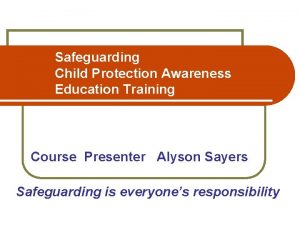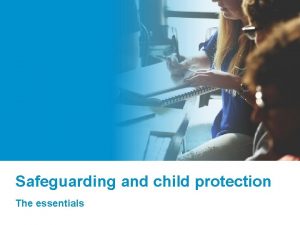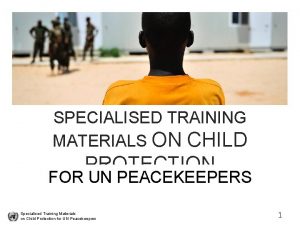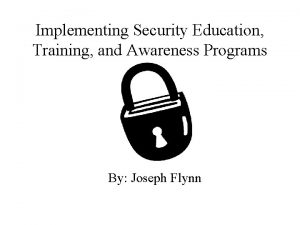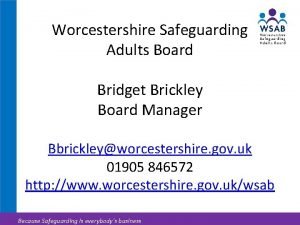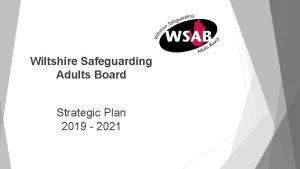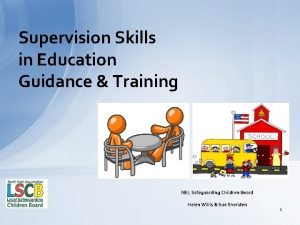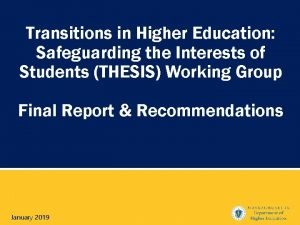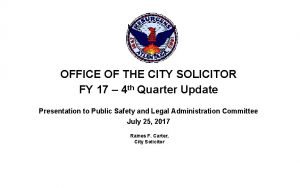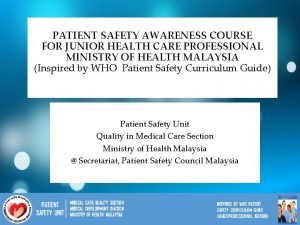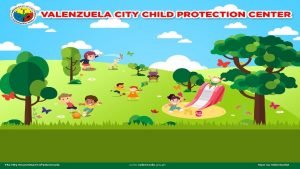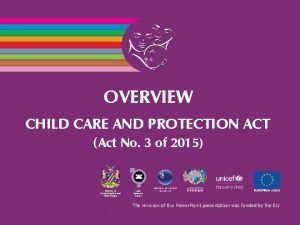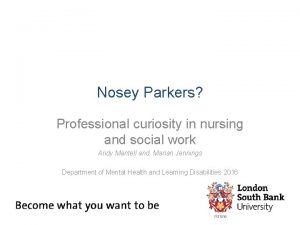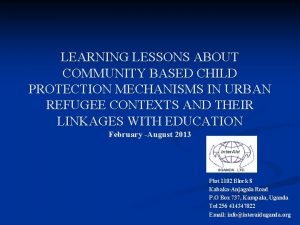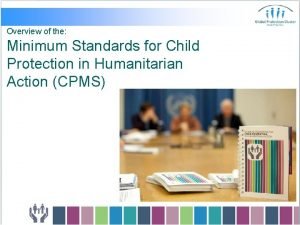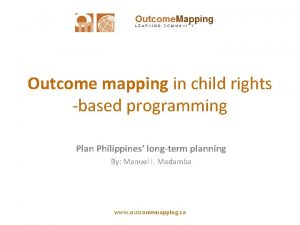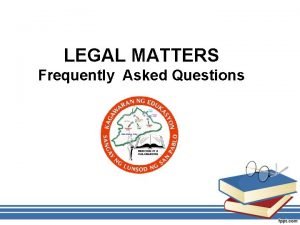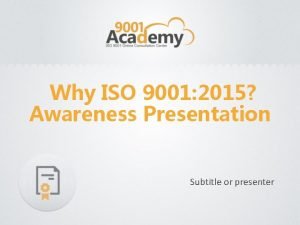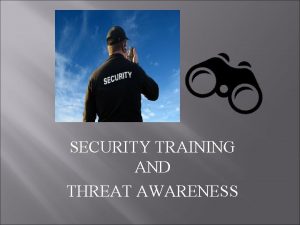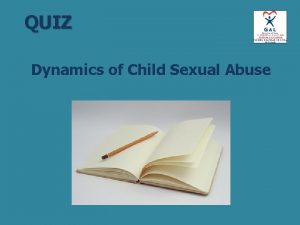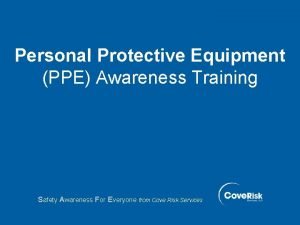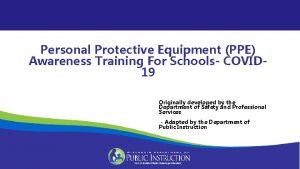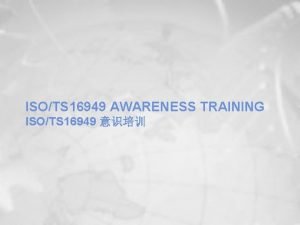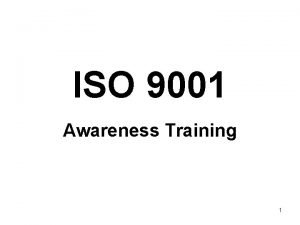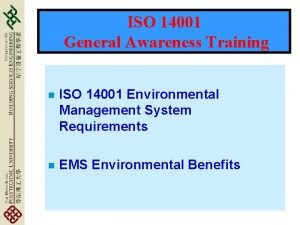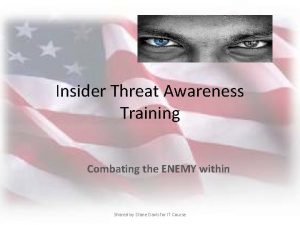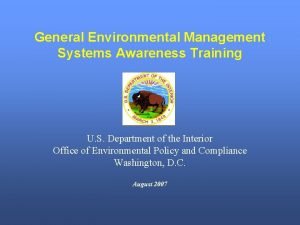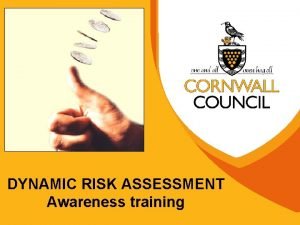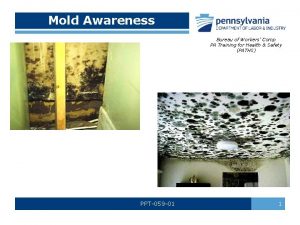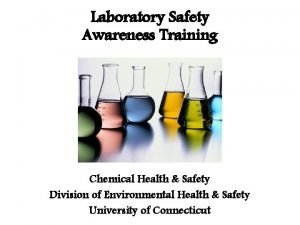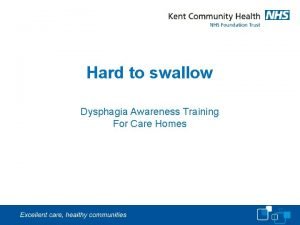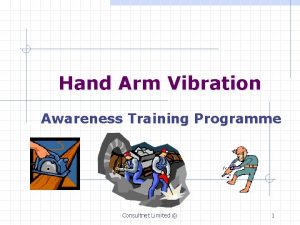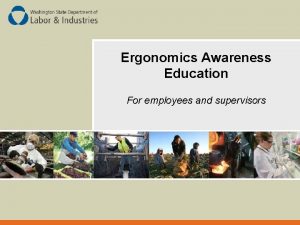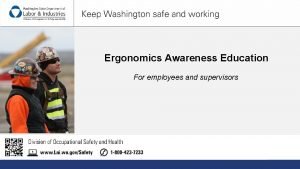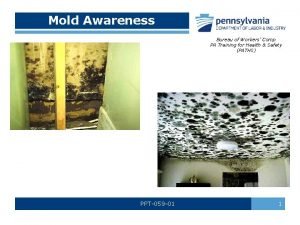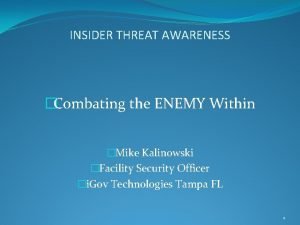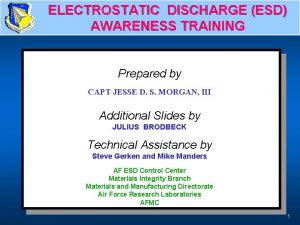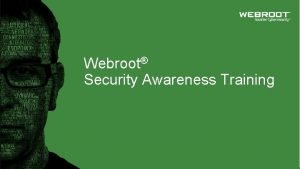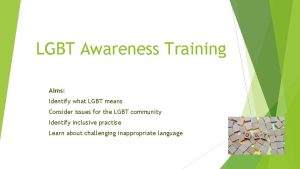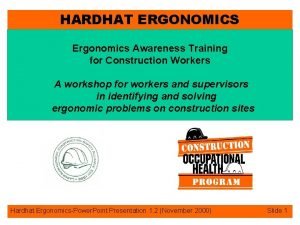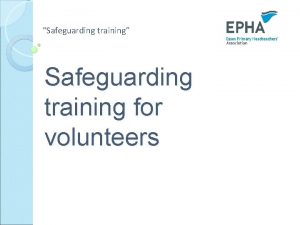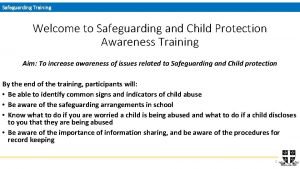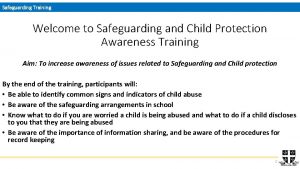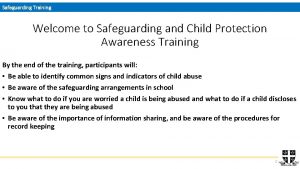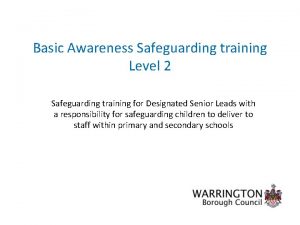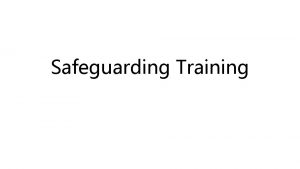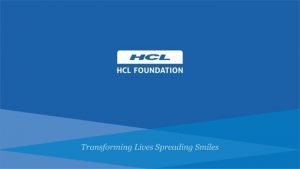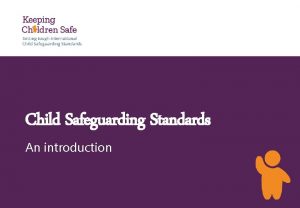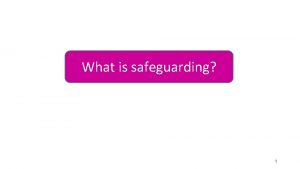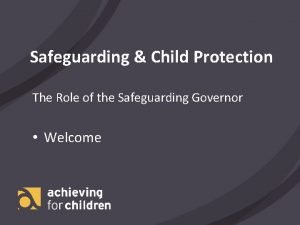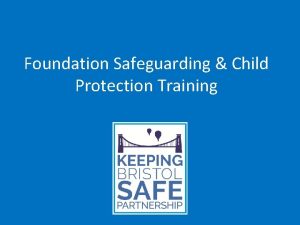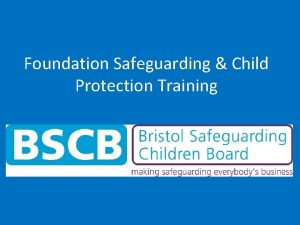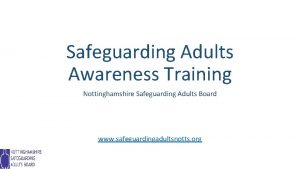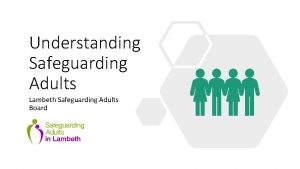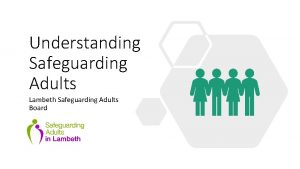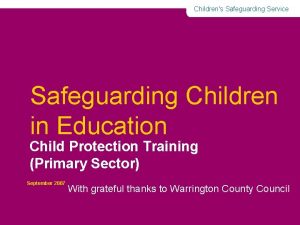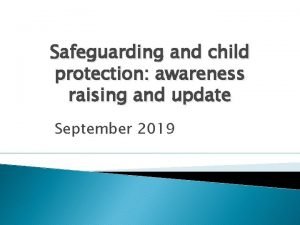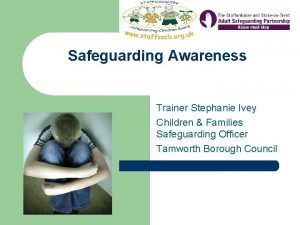Safeguarding Child Protection Awareness Education Training Course Presenter




















































- Slides: 52

Safeguarding Child Protection Awareness Education Training Course Presenter Alyson Sayers Safeguarding is everyone’s responsibility

Learning Outcomes At the end of this session participants will : • • • Be clear about key roles and responsibilities in and for schools re safeguarding children Understand the safeguarding agenda for schools and where child protection fits into this Be aware of different types of abuse and possible signs and symptoms Be clear about what to do if they are concerned about a child Be clear about how to respond to a child who tells them about possible abuse

Ground Rules • No such thing as a silly question • Value contributions & listen • • • Willingness to share your knowledge, review and reflect on practice • Jargon Create a safe environment/confidentiality • Mobile phones/texts/tablets Constructive challenge and feedback • Finish on time • Respect for subject matter- duty of care Respect for diversity and anti discriminatory practice

Safeguarding Quiz What do you remember about safeguarding? . . .

Current Key Legislation. . . • • • After Victoria Climbie and Peter Connelly… Local Safeguarding Children Board Children Act 1989 and 2004 Greater Accountability The Teachers Standards 2012 Working Together 2015 What to Do If You are Worried a Child is being abused. . . March 2015 The Prevent Duty June 2015 Keeping Children Safe in Education Sept 2016 Inspecting Safeguarding – Ofsted August 2016

Children Act 2004 The Act places a responsibility for the key agencies to safeguard all children and promote their welfare… Encourage agencies to share early concerns about the safety and welfare of children and to ensure preventive action before a crisis develops Section 11

Working Together to Safeguard Children 2015 “Child - anyone who has not yet reached their 18 th birthday” but includes the unborn child Includes those with additional vulnerabilities up to age of 25 years Professionals need to listen to the “child’s voice” and take into account the needs, wishes and feeling of the child

Safeguarding in Education Safe Recruitment & Selection Whistle-blowing Behaviour Management Extended Services PSHE & Curriculum Anti-Bullying Child Protection ICT / E-safety SEN and DSL Duty to Safeguard & Promote Welfare Attendance admissions exclusions PREVENT FGM/CSE Managing Allegations School Security & Physical Environment Staff Conduct (inc. volunteers)

Keeping Children Safe in Education 2016 All School and College Staff should: • • Be aware of child protection policy, staff behaviour policy and role of Designated Safeguarding Lead Be aware of signs of abuse and neglect Be aware of early help process/ understand their role in the process Know what to do if they have any concern about a child – difference between a concern/child in danger or at risk of harm Know what to do if a child discloses abuse or neglect Know process for making a referral Know what to do if they have concerns about safeguarding practices in the setting/or about a staff member

Keeping Children Safe In Education 2016 Staff members working with children are advised to maintain an attitude of “it could happen here” where safeguarding is concerned When concerned about the welfare of a child, staff members should always act in the BEST interests of the child”

Definition of Abuse Inflicting harm, or failing to act to prevent harm Children may be abused: • in a family • • • in an institutional or community setting by those known to the child more rarely, by a stranger Children may be abused • by an adult or adults • by another child

Group Activity What are the Indicators of Abuse? (Handout )

Physical Abuse • • • Shaking /biting Throwing objects Poisoning Burning / scalding Drowning Hitting Suffocating Smothering Use of implements • • • Pinching Strangulation Punching Otherwise causing physical harm When a carer fabricates symptoms or deliberately induces illness in a child

Common Sites for Accidental Injuries FOREHEAD NOSE CHIN BONY SPINE ELBOWS FOREARM HIP KNEES SHINS

Common Sites for Non Accidental Injuries EYES - bruising, black (particularly both eyes) CHEEK/SIDE OF FACE bruising, finger marks MOUTH - torn frenulum GENITALS bruising KNEES grasp marks Linear bruising. Outline of belt/buckles. Scalds/burns SKULL - fracture or bleeding under skull (from shaking) EARS - Pinch or slap marks, bruising SHOULDERS bruising, grasp marks UPPER & INNER ARM - bruising, grasp marks CHEST - bruising, grasp marks

Neglect Persistent failure to meet a child’s basic physical and/or psychological needs likely to result in the serious impairment of the child’s health or development, such as: • • • Substance misuse in pregnancy Fail to provide adequate food/shelter/clothing/ protection from danger and abandonment Fail to ensure adequate supervision Fail to provide appropriate medical care Fail to respond to child’s basic emotional needs

Emotional Abuse Persistent emotional ill-treatment of a child causing severe and persistent adverse effects on child’s emotional development: • Conveying that children are worthless/unloved • Imposing age-inappropriate expectations on children • Seeing/hearing the ill-treatment of another • Serious bullying/not allowing children to express their views/criticism/ ridicule • Exploiting & corrupting children • Racist/homophobic comments

Sexual Abuse Forcing or enticing a child or young person to take part in sexual activities, not necessarily involving a high level of violence, whether or not the child is aware of what is happening. • • The activities may involve physical contact, including assault by penetration Rape - Vaginal, Anal or Oral Masturbation Kissing Rubbing and touching outside of clothing

Sexual Abuse continued… • • Non-contact activities: Involving children in looking at, or in the production of, sexual images, Watching sexual activities Encouraging children to behave in sexually inappropriate ways Grooming a child in preparation for abuse (including via the internet). Women can also commit acts of sexual abuse, as can other children.

Positions of Trust Sexual Offences Act 2003 Children under the age of 18 years • Protects young people aged 16 and 17 who, even though they are over the age of consent, are particularly vulnerable to sexual abuse from people in positions of trust or authority • Occupations - will normally have power and authority /may have influence on child’s future. • Those who will have regular contact with the child/acting in loco parentis. Applies to: Education, Health, Social Care. . . •

Child Sexual Exploitation – New Definition Child Sexual Exploitation is a form of child sexual abuse. It occurs where an individual or group takes advantage of an imbalance of power to coerce, manipulate or deceive a child or young person under the age of 18 into sexual activity (a)in exchange for something the victim needs or wants, and/or (b) for the financial advantage or increased status of the perpetrator or facilitator. The victim may have been sexually exploited even if the sexual activity appears consensual. Child Sexual Exploitation does not always involve physical contact; it can also occur through the use of technology. See Definition and Guide for Practitioners/Annexes Guidance from Department for Education February 2017 Working Together to Safeguard Children 2015 updated February 2017

Indicators of Concern - CSE • • • Associating with other young people involved in exploitation Older boyfriends or girlfriends Sexually transmitted infections/unwanted pregnancy Mood swings/changes in emotional wellbeing Substance misuse/self harm/suicidal Inappropriate sexualised behaviour Going missing for periods of time or regularly coming home late Regularly missing school or not taking part in education Appearing with unexplained gifts or new possessions (often new mobile phones)

Child Sexual Exploitation – Dudley DVD – Emma’s Story Referral made via Multi Agency Referral Form (MARF) to Single Point of Access/MASH CSE Screening Tool/Toolkit to be completed NWG CSE Risk Assessment Tool West Midlands Police Information Report CSE Co-ordinator –Nikki Fernandes 01384 814984 07976 868831 nikki. fernandes@dudley. gov. uk

Specific Safeguarding Issues • • • Honour Based Violence Forced Marriage Trafficking Child Sexual Exploitation Domestic Servitude/Slavery Faith Abuse Female Genital Mutilation – Leyla’s story DVD Domestic Abuse Internet Abuse Bullying and many more

Female Genital Mutilation ‘the partial or total removal of the female genitalia… for cultural or other non therapeutic reasons’ - World Health Organisation Criminal Offence FGM places a child at significant harm Referral to Police/Single Point of Access Case Strategy Meeting Fine, imprisonment up to 14 years or both Mandatory reporting duty started on 31 st October 2015 Teachers, social workers and health professionals must report to police if. . . If a girl under 18 yrs discloses that an act of FGM has been carried out on her. Where they observe physical signs which appear to show that an act of FGM has been carried out on a girl under 18 years of age If a child perceived at risk of FGM – safeguarding procedures apply

Petals App – petals. coventry. ac. uk – Female Genital Mutilation • • • Downloadable app for children for mobile phone No search history recorded Shake phone to remove screen 1400 hits a day Advice, facts, quizzes, help available. App available for professionals Petals. coventry. ac. uk/professionals

Prevention of Extremism and Radicalisation • • Prevent - Government’s strategy to stop people becoming terrorists/ supporting terrorism, in all its forms Works at the pre-criminal stage by using early intervention Encourages individuals/communities to challenge extremist and terrorist ideology and behaviour. The Counter-Terrorism and Security Act 2015 -duty on schools and Colleges to have “due regard to the need to prevent people from being drawn into terrorism”. Prevent duty reinforces existing duties placed upon educational establishments for keeping children safe. Ofsted will inspect schools’ compliance with this duty. Channel – a programme which focuses on providing support at an early stage to people who are identified as being vulnerable to being drawn into terrorism

Values and Attitudes • Face the reality of Child Abuse… • Put the information into the context of the child as you know him/her • Be aware of your own personal values and attitudes

Working Together to Safeguard Children March 2015 states. . . • • • Early Help is more effective in promoting the welfare of children than reacting later Provides support as soon as a problem emerges at any point in a child’s life Prevents further problems events arising Local agencies work together to identify children and families who would benefit from early help Assessments undertaken to provide targeted early help services to address the assessed needs of a child and their family – better outcomes for the child

Early Help and Universal Services • • For children 0 -18 yrs or up to • 25 yrs - disability) Early Help Assessment recommended when child has • some additional needs Requirement when coordinated response from • more than one agency • required Obtain parental consent to share information Assessment should be signed by all family members over 16 yrs Early Help Assessments are sent to Family Centre in one of 5 cluster areas Screened to determine need Case taken to an Allocation Partnership Meeting (where resources required)

Information Sharing Guidance 2015 “Seven golden rules for information sharing” • • Remember that the Data Protection Act is not a barrier to sharing information Be open and honest Seek advice Share with informed consent where appropriate Consider safety and well-being Necessary, proportionate, relevant, accurate, timely and secure Keep a record

Child Protection Childs Welfare and Safety is Paramount. Do not alert parents if to do so would increase risk to child/children. Section 47… duty to investigate and protect from harm Section 17… providing services to children/families MUST discuss with parents/legal carers Early Help

DSCB Threshold Guidance


Some helpful responses if a child discloses to you • • • Believe the child Remain calm Take what the child says seriously Listen carefully - don’t interrupt Reassure them that they are not to blame Let them know what you are going to do to help Inform your Designated Safeguarding Lead without delay Record accurately - use the child’s words time/date/sign the record Use open questions – what, how, when, where, tell me what happened

What to avoid if a child confides in you. . . • • • Do not allow your shock or disgust to show Do not make assumptions Do not criticise abuser Do not make promises you cannot keep Do not agree to keep information secret Never delay emergency action to protect a child Never express disbelief in what the child is saying Do not try to interview the child Do not examine or undress the child Do not take photographs of any injury

Duty to Refer All professionals have a duty to refer cases where abuse is known to have occurred or is suspected. No professional has the right or responsibility to withhold information that may safeguard a child.

All referrals need to go to the Single Point of Access for Social Care and Early Help S. P. A –Telephone number 0300 555 0050 Out of hours – Emergency Duty Team 0300 555 8574 SPA - Provides advice, guidance and support Members of public can make referrals to SPA If the child is in immediate danger – please call 999 If you wish to make a referral using the Multi-Agency Referral Form (MARF), it can be found here: http: //safeguarding. dudley. gov. uk/report-it/ The form is sent to: spa team@dudley. gcsx. gov. uk Referrals will normally be made by your DSL but can be made by anyone.

Understanding Child Sexual Abuse Sex with a child Thoughts MOTIVATION ‘Wanting to’ INTERNAL INHIBITORS ‘Conscience’ OVERCOME VICTIM RESISTANCE ‘Doing it and getting Application’away with it’ EXTERNAL INHIBITORS Opportunity’ Finkelhor – ‘A Clinical Adapted from: - D Finkelhor Child Sexual Abuse: New Theory & Research 1986

Sexual Grooming • • • Pupil - special attention or preferential treatment Frequently spending time with a pupil in private or isolated areas Transporting a pupil possibly to or from school Making friends with a pupils parents and visiting their home Acting as a particular pupil’s “listening ear” Giving small gifts, money, toys, cards, letters to a pupil Using texts, telephone calls, e-mails or social networking sites to inappropriately communicate with a pupil Overly affectionate behaviour with a pupil Inappropriate comments or lesson content of a sexual nature Other pupils are suspicious and make jokes or references

Hillside First School- Nigel Leat • Leat started as an NQT in 1996 at the school at the age of 51 years old • Sexual abuse of children took place in school over a number of years prior to disclosure by a child in December 2010 – youngest victim was 6 years old • Total of 20 pupils-witnesses to/possible victims of abuse • May 2011 - Nigel Leat pleaded guilty to 36 sexual offences (including charges of Sexual Assault child U 13, Sexual Assault by Penetration Child U 13, Attempted Rape, Voyeurism, Causing or Inciting a child under 14 to commit sexual activity and possessing indecent images of children) • In June 2011 - given an indeterminate prison sentence for public protection, having pleaded guilty

Findings of the Serious Case Review: • • • At least 30 incidents of inappropriate conduct which should have been viewed as suspicious Incidents highlighted in the school management report ranged from indecent touching, inappropriate lesson content, favouritism and over-familiarity with children. Evidence of only one reference on file and no evidence that a second was sought. “On a number of occasions in response to these and other incidents colleagues advised Teacher A of the inappropriateness of his behaviour and pointed to the risk that he could be accused of professional misconduct It is significant however that only 11 of the 30 recorded incidents were reported to the school. "

Serious Case Review Findings These 5 predisposing factors … • • • mental ill health difficulties substance misuse by parent/carer domestic abuse parental learning disability neglect in a family suggest a higher level of risk Mental Health, Substance Misuse and Domestic Violence now known as “Trio of Vulnerabilities”

Learning from Serious Case Reviews • • • Each opportunity to intervene to protect children must be taken Domestic abuse/violence is a child protection issue The parent’s explanation must be balanced with objective information Assessment of risks within a family or to a particular child can never be effective without direct engagement with that child Don’t make assumptions on behalf of colleagues – check with them before making decisions Essential that professionals do not focus on concerning incidents in isolation

Learning From Serious Case Reviews • • • Any facial injuries to a child must be viewed with concern as should any injury/bruise to pre mobile baby See all injuries even minor ones in the context of other injuries/bruises Good record keeping is essential and central to professional child care practice A robust system is essential to ensure collation of concerns and actions Share information without delay Place yourself in the child’s shoes – how does it feel for them. . .

Dealing with allegations against staff who provide services for children If staff have… • behaved in a way that has harmed a child or may have harmed a child; • possibly committed a criminal offence against or related to a child; • behaved towards a child or children in a way that indicates that he or she would pose a risk of harm to children Police and Children’s Social Care co-ordinated by the Local Authority Designated Officer will investigate the matter

What should I do? . . . Keeping Children Safe in Education Sept 2016 • • Concerns about another staff member - refer to the head teacher or principal Concerns about the head teacher or principal - refer to chair of governors, chair of the management committee or proprietor of an independent school Concerns about poor safeguarding practices in school – whistle blowing procedures apply. Raise with school/college management team OR Local Authority Designated Officer 01384 813110 Ofsted 0300 123 3155 or www. ofsted. gov. uk NSPCC 0800 0285 or help@nspcc. org. uk

When you are Vulnerable? • • • Lone working Lawful restraint/behaviour management Children who want to help to tidy up P. E, swimming/other activities that require physical intervention or a change of clothing Extra-curricular activities Transporting children/Administering first aid When a child wants affection Provision of intimate care Mobile phones, social networking, face book, email communication, electronic notebooks Guidance for Safer Working Practice for those working with children and young people in education settings (Safer Recruitment Consortium) October 2015 or staff code of conduct

Safer Practice • Your behaviour should be open and transparent • You must adopt high standards of personal conduct • Your behaviour in or out of school must not compromise your position within the school • Avoid being alone with a student behind a closed, windowless door • Never give an individual student a gift that is not part of the ‘Rewards Policy’ • Never give your personal mobile number or personal e-mail address to a student • Be aware of the dangers of social networking site

Dudley Safeguarding Children Board Documents • Social Networking Services and Social Media Guidance for safeguarding children, young people and vulnerable adults • Dudley’s Thresholds Framework December 2015 • Dudley Safeguarding Children Board Procedures • West Midlands Child Protection and Safeguarding Procedures Manual - effective from April 1 st 2017 • Dudley Safeguarding Children Board Escalation Policy

Checklist - What do I Need to Know? • • Have you received and read the school’s safeguarding and child protection procedures? Do you understand the categories of abuse and recognise the possible indicators of concern? Have you read Part 1 of ‘Keeping Children Safe in Education’? Who are your Designated Safeguarding Lead(s)? Do you know how to record and pass on concerns? Have you received and read the School’s Code of Conduct or ‘Staff Handbook’? Do you know how to report a concern about another adult’s behaviour? If not, check with your DSL any queries you may have.

And finally… Please take time to complete your evaluations and make constructive comment Courses are constantly evolving and content will be guided by your feedback Thank you for your participation
 Child protection awareness training
Child protection awareness training Safeguarding and child protection the essentials
Safeguarding and child protection the essentials Cvs privacy awareness and hipaa privacy training
Cvs privacy awareness and hipaa privacy training Child protection training materials
Child protection training materials Seta security education training awareness
Seta security education training awareness Child safeguarding standards
Child safeguarding standards Worcestershire safeguarding board
Worcestershire safeguarding board Wiltshire safeguarding
Wiltshire safeguarding Wonnacott discrepancy matrix
Wonnacott discrepancy matrix Safeguarding in higher education
Safeguarding in higher education Ptit safe driving and awareness course
Ptit safe driving and awareness course Patient safety goals - awareness course
Patient safety goals - awareness course Basic electrical awareness course
Basic electrical awareness course Courage child protection
Courage child protection Opinyon tungkol sa child protection policy
Opinyon tungkol sa child protection policy Children's rights and responsibilities posters
Children's rights and responsibilities posters Child marriage definition
Child marriage definition Child protection case management tools
Child protection case management tools Types of child protection
Types of child protection Child protection and toy safety act
Child protection and toy safety act Professional curiosity
Professional curiosity Community based child protection mechanisms
Community based child protection mechanisms Child care and protection act 3 of 2015
Child care and protection act 3 of 2015 Child protection minimum standards
Child protection minimum standards Child protection policy in schools example
Child protection policy in schools example 2 disinterested person
2 disinterested person Child protection reform amendment act 2017
Child protection reform amendment act 2017 Iso 9001 presentation
Iso 9001 presentation Suspicious packages training
Suspicious packages training Ncic restricted files list
Ncic restricted files list Was i sexually abused as a child quiz
Was i sexually abused as a child quiz Ppe awareness
Ppe awareness Ppe awareness training
Ppe awareness training Sogedac
Sogedac Iso 9001:2015 awareness training
Iso 9001:2015 awareness training Iso 14001 2015 awareness training
Iso 14001 2015 awareness training Which of the following are reportable behavioral indicators
Which of the following are reportable behavioral indicators Environmental management system awareness training
Environmental management system awareness training Dynamic risk assessment
Dynamic risk assessment Mold awareness training
Mold awareness training Ozone hazard symbol
Ozone hazard symbol Dysphagia training
Dysphagia training Hand arm vibration awareness training
Hand arm vibration awareness training Ergonomics awareness training for supervisors
Ergonomics awareness training for supervisors Ergonomics awareness training for supervisors
Ergonomics awareness training for supervisors Sfar 73 awareness training
Sfar 73 awareness training Mold awareness training
Mold awareness training Insider threat awareness training
Insider threat awareness training Esd awareness training
Esd awareness training Phishing
Phishing Lgbt awareness training
Lgbt awareness training Find ergonomics awareness training
Find ergonomics awareness training Rf safety awareness training answers
Rf safety awareness training answers
